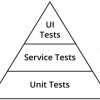Related Content
 |
Bringing Empathy into Quality Engineering Testers have always been advocates for the end-user. But there are now more opportunities to be that advocate, including emotional intelligence-based testing and role-based testing, which form a critical part of empathetic testing. Building empathy into our software engineering process ends up benefiting everyone. |
|
 |
Top Down or Bottom Up? Designing Effective Test Automation Test automation is not necessarily a technical challenge. The real focus is on the structure and design of the tests and their automation, in particular for tests that need to run through the UI. As with software, tests can be designed from the top down or from the bottom up. Which is better for test automation? |
|
 |
Rebuilding Your Test Strategy If testing is taking awhile and a lot of bugs are getting into production, it's a good idea to review your entire test strategy. Spend some time understanding the current process and what testing is happening through the dev process—not what is outlined in a process wiki, but the work that actually happens. |
|
 |
Top 10 TechWell Insights Stories of 2018 Many teams are embracing new practices, and several of last year's most-read stories reflect that, with topics such as AI, DevOps, and continuous testing. But it looks like lots of teams also want to get back to basics, because guides to tried-and-true agile and testing methods also ranked high. Check out the roundup. |
|
 |
Protect Your Software through Threat Modeling Many software organizations are overwhelmed with a laundry list of vulnerabilities. They often have no idea where to start, how to determine prioritization, and whether or not those vulnerabilities accurately represent the threats to our applications, users, and data. Threat modeling is a simple yet effective solution. |
|
 |
Testing the Ethics of AI AI is a double-edged sword. When it's being used in situations involving sensitive personal data, such as health care, banking and finance, and real estate, security is of the utmost importance—and so are ethical implications. It’s up to testers to mitigate risks and make sure AI is used responsibly. |
|
 |
Who Should Be Doing Automation Work? Testers often look at automation work as the next career step after manual testing. Automation work has more visibility at the project level, and people who do this work usually also tend to have a little more social status. But Justin Rohrman makes a case for why testers shouldn't be the ones doing automation work. |
|
 |
5 Reasons You Should Have More Unit Tests The test pyramid is a valuable visual in agile. In particular, it argues that unit tests should make up the majority of tests, and while agile teams recite this principle, it is often not clear why it is so important. Here are five reasons unit tests should make up the majority of tests written for an application. |






